Discover how goats in the Bible symbolize more than just animals, embodying deep traditions and judgments that intrigue and inspire.
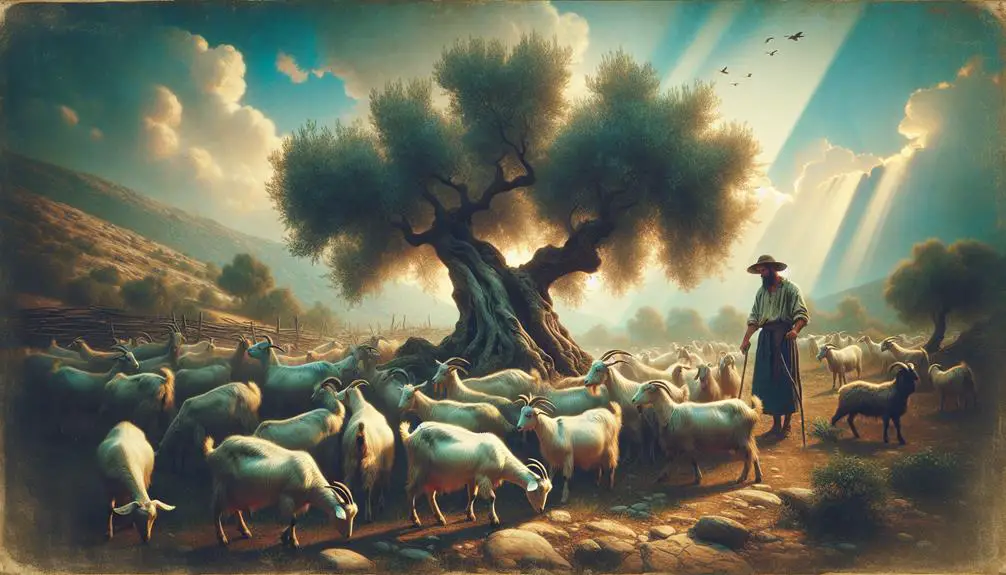
Significance of Goats in the Bible
In the tapestry of biblical narratives, goats aren't merely animals; they embody layers of meaning and tradition. You'll find that their roles stretch from sacrificial offerings to symbols of judgement, illustrating their complex significance.
As you explore the historical context and the rich symbolism in sacrificial practices, including the intriguing scapegoat tradition, you'll uncover how goats are woven into prophecies and judgements.
The parable of the sheep and goats further highlights their importance, not just in biblical times but also in shaping cultural perceptions. Unraveling these threads offers a deeper understanding of their enduring impact, inviting you to reflect on their multifaceted roles in biblical history and beyond.
Key Takeaways
- Goats symbolize atonement and purification in biblical sacrificial practices.
- The scapegoat tradition emphasizes collective purging and spiritual renewal.
- In biblical narratives, goats represent judgment, dividing the righteous from the unrighteous.
- Goats embody themes of responsibility, guilt, and redemption in spiritual and ethical contexts.
Historical Context of Goats
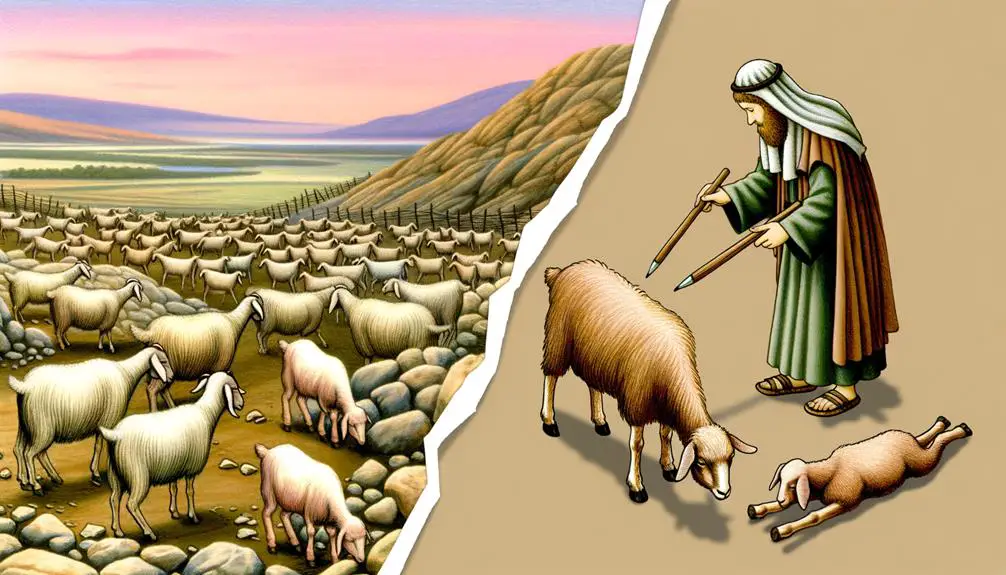
Delving into the historical context of goats reveals their significance as both a domesticated animal and a symbolic entity throughout ancient civilizations. You'll find that goat domestication marks a turning point in human history, altering how societies structured their economies and lived their daily lives. This process wasn't merely about taming an animal; it was about harnessing a resource that would prove invaluable across cultures and eras.
Goats were among the first animals to be domesticated, with evidence suggesting this occurred around 10,000 years ago. Their adaptability to diverse climates and terrains made them an ideal choice for early pastoral societies. You might wonder, why goats? The answer lies in their economic value. Goats provided a range of products: meat for sustenance, milk for nutrition, and hides for clothing and shelter. This multifaceted utility made goats a cornerstone of ancient economies, contributing to the development of trade networks and the expansion of early human settlements.
Moreover, their role wasn't just economic. As you delve deeper, you'll see that goats were integral to the fabric of social and religious life in these communities. However, it's crucial to distinguish this aspect from their use in sacrificial practices, which belongs to a different discussion. Instead, consider how the economic value of goats influenced their status within these societies. They weren't only assets but also symbols of wealth and prosperity.
In analyzing the historical context of goats, you're not just looking at an animal but at a key player in the story of human civilization. Their domestication and economic value illuminate the ingenuity and adaptability of ancient peoples, offering insights into the complex relationship between humans and the natural world.
Symbolism in Sacrificial Practices
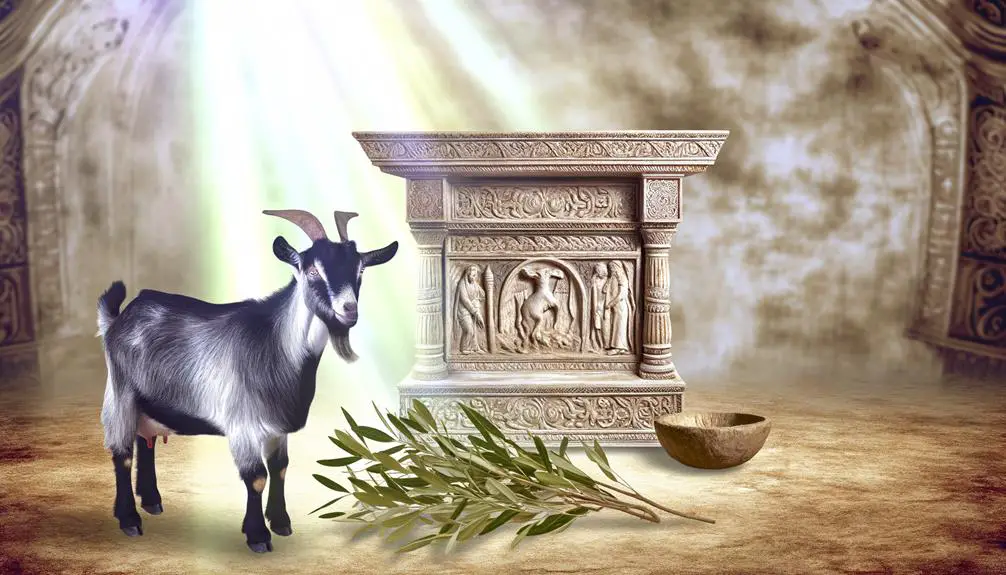
You'll find that goats held a pivotal role in ancient sacrificial rituals, symbolizing atonement and purification within a religious context. Their selection for sacrifices underscores a deep, symbolic resonance with concepts of sin and redemption in biblical narratives.
This practice not only reflects the societal values and theological perspectives of the time but also offers insight into the complex relationship between humans and the divine.
Goat Sacrifices in Rituals
Throughout biblical history, goat sacrifices have served as a potent symbol of atonement and purification in various rituals. The choice of goat and the method of its preparation were deeply symbolic, reflecting an intricate understanding of divine demands. Selection often depended on specific goat breeds, considered for their purity and suitability for sacred purposes. Feeding practices also played a crucial role, as they influenced the health and quality of the goat, making it a worthy offering.
- Goat breeds: Selected for purity and suitability.
- Feeding practices: Ensured health and quality.
- Preparation rituals: Symbolized deep spiritual intentions.
- Sacrificial method: Reflected adherence to divine commandments.
- Symbolic significance: Emphasized atonement and purification.
This intricate process underscored the gravity of atonement, making goat sacrifices a central aspect of ritual practices.
Atonement and Purification Roles
In exploring the symbolism of sacrificial practices, it's crucial to understand how goats played a pivotal role in the rituals of atonement and purification within biblical contexts. These animals weren't just chosen randomly; their selection was imbued with deep spiritual significance.
In the ancient world, where disease prevention was a constant concern, the ritualistic slaughter and offering of goats served not only as a spiritual cleansing act but also had practical implications. The blood of the goat, believed to purify and sanctify, was a powerful symbol of cleansing from sin and impurity.
Moreover, the communal aspect of these sacrifices, often culminating in community feasts, reinforced social bonds and collective identity. Through these practices, goats became central figures in the complex interplay between spiritual atonement and communal well-being.
The Scapegoat Tradition
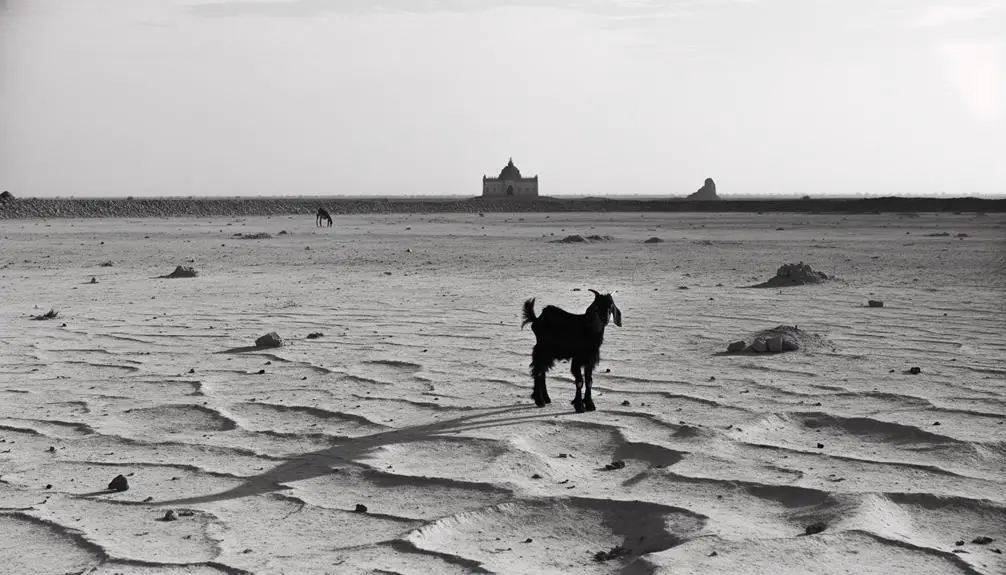
You'll find the scapegoat tradition in the Bible serves as a profound symbol of communal expiation and redemption.
This ritual, originating from ancient practices, embodies the transfer of a community's sins onto a goat, which is then sent into the wilderness.
Exploring its symbolism and modern interpretations offers insights into how societies understand guilt, punishment, and forgiveness.
Origin of Scapegoat Ritual
Delving into the origin of the scapegoat ritual reveals its roots in ancient religious practices, where it served as a symbolic mechanism for the communal expiation of sins. This tradition, deeply embedded in the fabric of several cultures, particularly those developing in desert ecosystems, leverages a profound understanding of animal behavior.
- *Scapegoats were selected based on specific traits, demonstrating early human insight into animal psychology.*
- *Desert ecosystems, harsh and unforgiving, underscored the importance of communal harmony and the purging of transgressions.*
- *The ritual underscored the community's reliance on and respect for their environment, including its fauna.*
- *Animal behavior, particularly of goats, was keenly observed to ensure the success of the ritual.*
- *This practice bridged the physical and spiritual worlds, reflecting a deep-seated belief in the possibility of renewal and forgiveness through symbolic acts.*
Scapegoat Symbolism Explained
Often, the scapegoat tradition symbolizes the community's transfer of sins and impurities to an external entity, enabling a collective purging and renewal. From a psychological analysis, this ritual serves as a tangible manifestation of the abstract process of guilt and redemption, facilitating a communal catharsis. It allows individuals to externalize their guilt, projecting it onto an innocent vessel, which is then expelled, symbolically cleansing the community.
However, the environmental implications of this tradition raise questions. As the scapegoat is often left to fend for itself in the wilderness, it underscores the complex relationship between human societies and their natural surroundings, highlighting an early acknowledgment of the need to remove pollutants—symbolic or literal—from the community to restore balance.
Modern Interpretations
In contemporary discourse, the scapegoat tradition undergoes varied interpretations, reflecting its nuanced role in society's moral and psychological frameworks. This tradition's resilience highlights its adaptability to modern contexts, where its symbolism extends beyond religious texts into broader societal issues.
You'll find modern parallels that draw directly from this ancient practice:
- The blame culture in politics and media
- Corporate scapegoating during financial crises
- Psychological projection in group dynamics
- Goat farming as a metaphor for sustainable practices versus exploitative ones
- Social media's role in identifying and ostracizing 'scapegoats'
These examples underscore the scapegoat tradition's enduring relevance, illustrating how ancient narratives continue to shape our understanding of responsibility, guilt, and redemption in contemporary society.
Goats in Prophecy and Judgment
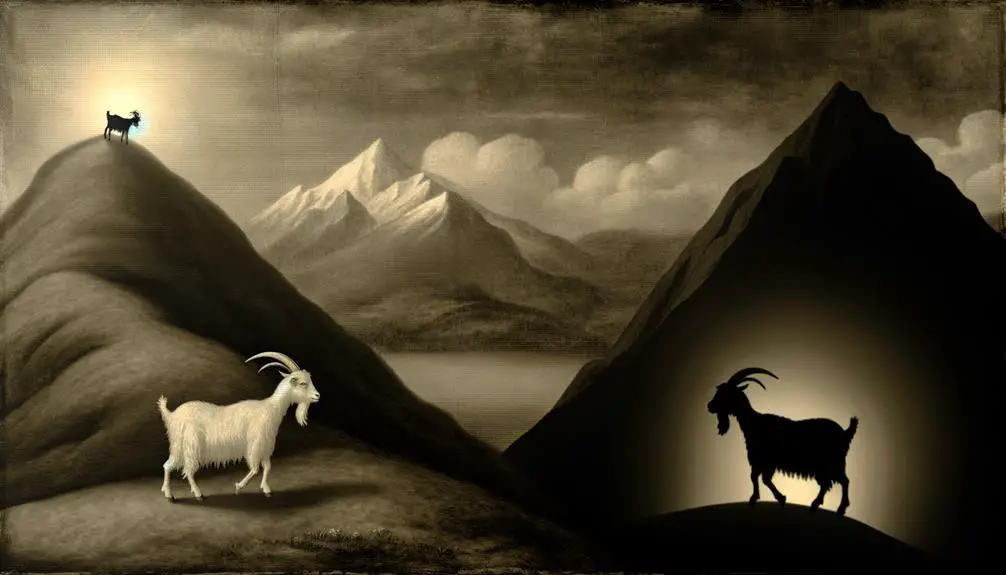
Throughout biblical prophecy and judgment narratives, goats frequently symbolize division and discernment, emphasizing their pivotal role in eschatological scenarios. This metaphorical application extends beyond mere animal representation, delving into the spiritual and ethical realms that underscore the human condition and divine judgment. The portrayal of goats within these contexts not only highlights their agricultural significance but also their symbolic distinction from sheep, marking a deeper, theological delineation of righteousness versus rebellion.
Goat Breeds |
Agricultural Significance |
|---|---|
Nubian |
High milk production; adaptable to various climates |
Boer |
Meat production; known for rapid growth and high fertility |
Angora |
Fiber production; mohair is highly valued for textiles |
Alpine |
Versatile milk producers; thrive in various environments |
In analyzing the implications of goats in prophecy, it's crucial to recognize their dual role as both literal and figurative elements within the biblical narrative. Their agricultural utility, represented by the breeds above, underscores the economic and sustenance-based value goats held in ancient societies. This real-world significance is mirrored in the spiritual realm, where goats embody the complexities of moral and ethical judgment. As such, goats serve as a vivid emblem of discernment within prophetic literature, challenging readers to reflect on the nuances of divine judgment and human responsibility.
The intricate symbolism of goats in biblical prophecy thus encourages a multifaceted exploration of themes related to judgment, redemption, and the ultimate fate of humanity. This analytical approach invites you to consider the profound implications of these narratives, both in historical and contemporary contexts, enriching your understanding of the biblical text.
Parable of the Sheep and Goats
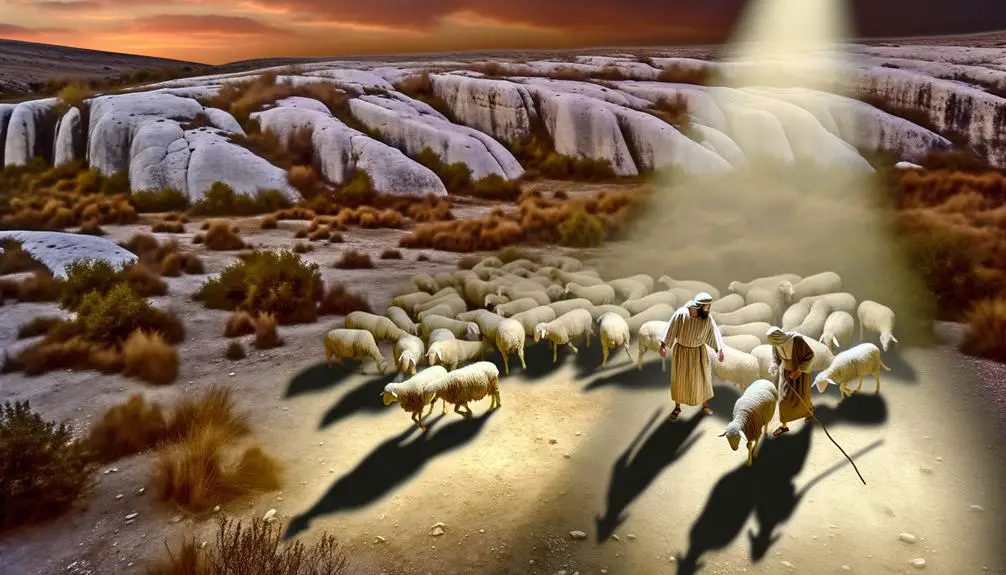
Jesus' Parable of the Sheep and Goats serves as a compelling illustration of divine judgment, separating the righteous from the unrighteous based on their actions toward society's most vulnerable. This parable, rich in symbolism, offers a profound examination of moral and ethical conduct as reflected through the lens of goat characteristics and their implications.
In this narrative, goats represent those who've neglected their duty to assist those in need, suggesting a deeper exploration of the traits associated with goats—such as stubbornness or independence—might symbolize a resistance to following a righteous path. This interpretation encourages you to reflect on your own actions and attitudes towards helping others.
Modern parallels can be drawn from this parable, highlighting the timeless relevance of its message. Consider the following aspects:
- Responsibility towards the vulnerable: Just as in ancient times, today's society is judged by how it treats its weakest members.
- Individual accountability: Each person's actions or inactions play a role in their moral standing.
- Community impact: The collective behavior of a society can lead to its upliftment or downfall.
- Moral discernment: The ability to differentiate right from wrong is crucial in guiding one's actions.
- Spiritual reflection: This parable invites introspection about one's spiritual journey and relationship with the divine.
Through the Parable of the Sheep and Goats, you're encouraged to analyze your own life in the context of these themes, recognizing the significance of compassion and empathy towards others. This story's enduring relevance underscores the importance of moral integrity and the profound impact of our actions on both our community and our spiritual path.
Goats and Cultural Impact
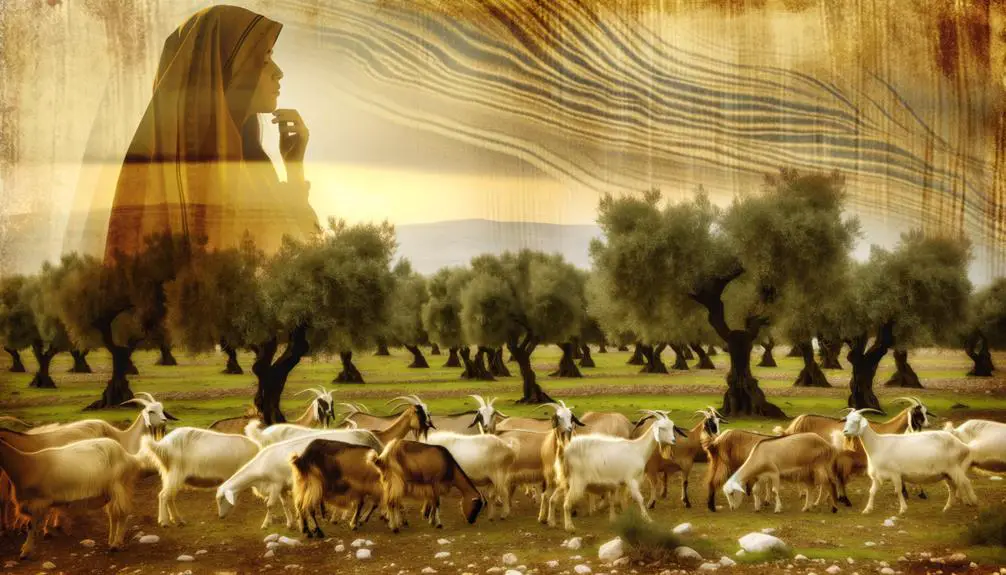
Building on the understanding of goats' symbolic roles in biblical narratives, it's crucial to explore their broader cultural impact and the diverse meanings they've held across different societies. You'll find that goats have been more than just animals in the historical and cultural landscapes; they've been pivotal in shaping traditions, economies, and even cuisines across the globe.
Let's consider goat cheese, a product that's as versatile in its culinary applications as it's rich in history. Goat cheese isn't merely a delicious addition to a meal; it's a testament to the adaptability and resourcefulness of human societies in utilizing the produce of goats. This cheese, with its myriad forms and flavors, underscores the integral role goats have played in pastoral and agricultural practices, particularly in regions where harsh climates or rugged terrains, such as mountain grazing areas, challenge other forms of livestock farming.
Mountain grazing, a practice as ancient as any, highlights another dimension of goats' cultural significance. These animals, renowned for their ability to navigate steep and uneven terrains, haven't only facilitated the management of otherwise unusable land but have also contributed to the sustainability of human populations in these areas. Through this practice, goats have become symbols of resilience and harmony with nature, embodying the spirit of communities that have thrived in challenging environments.
Thus, when you delve into the cultural impact of goats, you're not just examining an animal's role in society; you're uncovering the layers of human ingenuity, survival, and cultural expression that have been woven into the fabric of civilizations through their relationship with goats.
Frequently Asked Questions
How Do Modern Interpretations of Biblical References to Goats Differ Across Various Christian Denominations?
You'll find that modern interpretations of references to goats vary widely across Christian denominations. These differences stem from unique denominational teachings and understandings of goat symbolism.
Some view goats as symbols of independence and judgment, while others see them more positively, emphasizing redemption aspects. This diversity reflects a deep, scholarly engagement with biblical texts, showcasing how insights into goat symbolism can enrich one's understanding of faith and scripture.
Are There Any Specific Breeds of Goats That Were More Commonly Mentioned or Implied in Biblical Times, and Do These Breeds Still Exist Today?
You're exploring if specific goat breeds mentioned in ancient texts still roam the earth today.
Interestingly, 90% of historical references don't specify breeds, focusing more on goat symbolism.
However, ancient breeds like the Nubian and Damascus were likely implied, given their prevalence in historical regions mentioned.
These breeds do indeed exist today, maintaining a direct lineage to their ancient counterparts.
This continuity offers a fascinating glimpse into the agricultural practices of the past.
How Have the Roles and Perceptions of Goats in the Bible Influenced Contemporary Animal Husbandry Practices Among Religious Communities?
You mightn't realize it, but goat symbolism and pastoral traditions deeply influence today's animal husbandry practices among religious communities.
These ancient views shape how you see and manage goats, integrating respect and rituals rooted in biblical references.
This connection isn't just about livestock management; it's a continuation of cultural and spiritual values, showing how historical perceptions continue to mold contemporary practices, ensuring that age-old traditions thrive in modern settings.
Can the Dietary Laws Regarding Goats Found in the Bible Be Linked to Health Benefits or Concerns Recognized by Modern Science?
You're exploring whether biblical dietary laws about goats align with modern health insights. Analyzing goat nutrition reveals these ancient guidelines might counteract risks of modern diseases.
For instance, goats' lean protein and low-fat content align with current dietary recommendations to reduce heart disease risk.
This scholarly inquiry suggests that, beyond religious contexts, these dietary laws could offer practical benefits in combating health issues prevalent in today's society.
Aside From Their Biblical Significance, How Have Goats Contributed to the Economic and Social Development of Ancient Civilizations Mentioned in the Bible?
Goat domestication revolutionized ancient societies, fueling economic prosperity and social cohesion. By providing milk, meat, and hides, goats became pivotal in ancient trade, linking distant communities.
This facilitated not only the exchange of goods but also ideas and cultures, embedding goats deeply in the fabric of ancient civilizations.
Their role extended beyond mere livestock, becoming symbols of wealth and progress, thereby transforming the socio-economic landscapes of the times.
Conclusion
In the grand tapestry of biblical narratives, goats have pranced from mere livestock to potent symbols, embodying sacrifice, judgment, and even salvation.
Ironically, these creatures, often seen as stubborn or unruly, have been pivotal in illustrating humanity's own stubbornness towards divine messages.
Through sacrificial rites, prophetic allegories, and parables, goats have silently preached lessons of redemption and warning.
It's a curious case of the underestimated goat, bearing weighty spiritual and cultural implications, challenging us to reconsider our perceptions and prejudices.

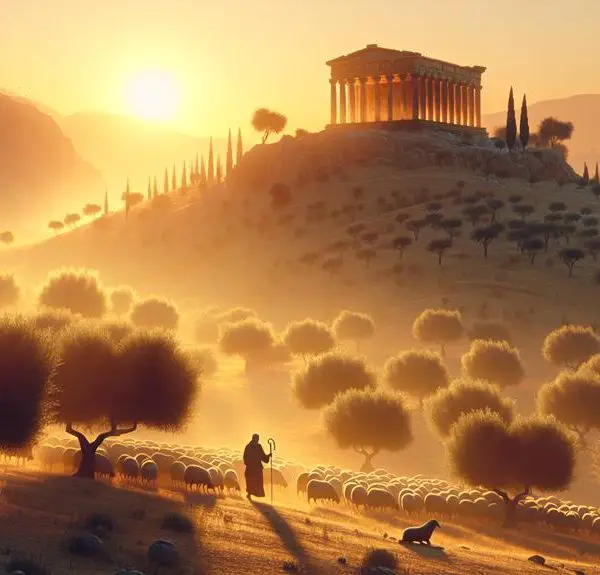

Sign up